Commutative Quaternion Algebra with Quaternion Fourier Transform-Based Alpha-Rooting Color Image Enhancement †
Abstract
1. Introduction
- The separable alpha-rooting method of color image enhancement;
- New two-parameter alpha-rooting methods of color image enhancement;
- The effectiveness of using the 2D QDFT-based alpha-rooting in the (2,2)-model;
- Illustrative examples showing the effectiveness of using the (2,2)-model in color image enhancement.
2. Quaternion Numbers: Two Arithmetics
2.1. The (1,3)-Model of Quaternions
2.2. The (2,2)-Model of Quaternions
- The multiplication is commutative, .
- The multiplication unit is the quaternion . For this real unit for any quaternion .
- The multiplication rules of four quaternion units , and are given in Table 1. It should be noted that for two quaternion units and , the square is For the other two units and , the square is .
- The multiplication is associative, that is, for any quaternions , , and .
- The multiplication is distributive, that is, .
- The zero quaternion has “divisors.” For instance, the multiplication of two quaternions and is equal to
- The inverse to the non-zero quaternion is calculated by
- The inverse operation exists for all , except the quaternions of the form For quaternion exponential numbers, the inverse exists. As mentioned in [24], the absence of some inverse numbers is not an obstacle when using quaternions to process signals and color images.
- The division of quaternions and is calculated by .
- The multiplication of a quaternion on its conjugate is equal to the following quaternion:
- In the general case, is not a real number and cannot be used to define the modulus of the quaternion in the traditional sense. For example,
- The length, or modulus, of the quaternion is defined as , where the energy of the quaternion number is calculated by
3. The Quaternion Exponents in the (2,2)-Model
4. Quaternion Discrete Fourier Transforms
- When the quaternion is and the angle is , the basis exponential functions are
- 2.
- In the case, the basis exponential functions for the QDFT are
5. Processing Images in the (2,2)-Model
5.1. Method of Alpha-Rooting by the 2D QDFT
- Compose the quaternion image from the given RGB color image, .
- Calculate the 2D -QDFT of the quaternion image, .
- Calculate the module of the transform,
- Process the transform modules by the alpha-rooting, .
- 5.
- Calculate the inverse 2D -QDFT, .
- 6.
- Multiply the image by the constant to raise the range of the image.The output of the alpha-rooting is the quaternion image Rounding to integers is required.
- 7.
- Compose the new color image, , as the three-component imaginary part of the quaternion image .
- 8.
- Extract the new grayscale image from the quaternion image , as its real part. Note that this grayscale image is not the gray or brightness of the new color image .
- A.
- Enhancement measures for grayscale images
- The estimated measure of enhancement entropy measure (EMEE)
- 2.
- The Michelson enhancement measure (MEM)where the Michelson visibility ratio is calculated by
- 3.
- The signal-noise ratio (or the ratio of the mean of the image and standard deviation)where
- B.
- Alpha-rooting components-wise
- C.
- Comparison with HE and Retinex
5.2. The Separable Alpha-Rooting
- The separable 1-parameter alpha-rooting of the quaternion image is the method of processing the 2D -QDFT of the image as
- The 2-parameter alpha-rooting of the quaternion image uses two parameters and from the interval to process the 2D -QDFT of the quaternion image as follows:
5.3. Alpha-Rooting of Color Images and the (1,3)-Model
- Compose the quaternion image from the color RGB image .
- Calculate the right-sided 2D QDFT, of the quaternion image.
- Given , calculate the coefficients .
- Modify the 2D QDFT as .
- Calculate the inverse 2D QDFT .
- Select the best value for color image enhancement by using the measures EMEQ or EMEC.
6. Experimental Results with Color Images
7. Conclusions
Author Contributions
Funding
Data Availability Statement
Acknowledgments
Conflicts of Interest
References
- Harris, J.L. Constant variance enhancement: A digital processing technique. Appl. Opt. 1977, 16, 1268. [Google Scholar] [CrossRef] [PubMed]
- Wang, D.C.; Vagnucci, A.H.; Li, C.C. Digital image enhancement: A survey. Comput. Vis. Graph. Image Process. 1983, 24, 363–381. [Google Scholar] [CrossRef]
- Trussell, H.J.; Saber, E.; Vrhel, M. Color image processing [basics and special issue overview]. IEEE Signal Process. Mag. 2005, 22, 14–22. [Google Scholar] [CrossRef]
- Gonzalez, R.C.; Woods, R.E. Digital Image Processing, 4th ed.; Pearson: New York, NY, USA, 2018. [Google Scholar]
- Grigoryan, A.M.; Agaian, S.S. Image processing contrast enhancement. In Wiley Encyclopedia of Electrical and Electronics Engineering; Webster, J.G., Ed.; Wiley: Hoboken, NJ, USA, 2017; pp. 1–22. [Google Scholar]
- Nithyananda, C.R.; Ramachandra, A.C.; Preethi. Survey on histogram equalization method-based image enhancement techniques. In Proceedings of the 2016 International Conference on Data Mining and Advanced Computing (SAPIENCE), Ernakulam, India, 16–18 March 2016; IEEE: New York, NY, USA, 2016; pp. 150–158. [Google Scholar]
- Han, J.-H.; Yang, S.; Lee, B.-U. A novel 3-D color histogram equalization method with uniform 1-D gray scale histogram. IEEE Trans. Image Process. 2011, 20, 506–512. [Google Scholar] [CrossRef] [PubMed]
- Trahanias, P.E.; Venetsanopoulos, A.N. Color image enhancement through 3-D histogram equalization. In Proceedings of the 11th IAPR International Conference on Pattern Recognition, The Hague, The Netherlands, 30 August–3 September 1992; IEEE Comput. Soc. Press: Washington, DC, USA, 1992; Volume IV, pp. 545–548. [Google Scholar]
- Pitas, I.; Kiniklis, P. Multichannel techniques in color image enhancement and modeling. IEEE Trans. Image Process. 1996, 5, 168–171. [Google Scholar] [CrossRef] [PubMed]
- Mlsna, P.A.; Zhang, Q.; Rodriguez, J.J. 3-D histogram modification of color images. In Proceedings of the 3rd IEEE International Conference on Image Processing, Lausanne, Switzerland, 16–19 September 1996; IEEE: New York, NY, USA, 1996; Volume 3, pp. 1015–1018. [Google Scholar]
- Land, E.H.; McCann, J.J. Lightness and retinex theory. J. Opt. Soc. Am. 1971, 61, 1–11. [Google Scholar] [CrossRef]
- Land, E. An alternative technique for the computation of the designator in the retinex theory of color vision. Proc. Natl. Acad. Sci. USA 1986, 83, 3078–3080. [Google Scholar] [CrossRef] [PubMed]
- Agaian, S.S.; Panetta, K.; Grigoryan, A.M. Transform-based image enhancement algorithms with performance measure. IEEE Trans. Image Process. 2001, 10, 367–382. [Google Scholar] [CrossRef] [PubMed]
- Grigoryan, A.M.; Agaian, S.S. Quaternion and Octonion Color Image Processing with MATLAB; SPIE Press: Bellingham, WA, USA, 2018. [Google Scholar]
- Gauss, C.F. Mutationen des raumes [transformations of space] (c. 1819). In Carl Friedrich Gauss Werke, 8th ed.; Brendel, M., Ed.; Teubner: Stuttgart, Germany, 1900; pp. 357–361. [Google Scholar]
- Hamilton, W.R. On a new species of imaginary quantities connected with a theory of quaternions. Proc. R. Ir. Acad. 1844, 2, 424–434. Available online: https://www.emis.de/classics/Hamilton/Quatern1.pdf (accessed on 27 December 2024).
- Hamilton, W.R. Elements of Quaternions; Longmans, Green & Co.: London, UK, 1866. [Google Scholar]
- Kantor, I.L.; Solodovnikov, A.S. Hypercomplex Numbers; Nauka: Moscow, Russia, 1973. [Google Scholar]
- Bülow, T. Hypercomplex Spectral Signal Representations for the Processing and Analysis of Images; Christian-Albrechts-Univ.: Kiel, Germany, 1999; Volume 9903, p. 171. [Google Scholar]
- Yin, Q.; Wang, J.; Luo, X.; Zhai, J.; Jha, S.K.; Shi, Y.-Q. Quaternion convolutional neural network for color image classification and forensics. IEEE Access 2019, 7, 20293–20301. [Google Scholar] [CrossRef]
- Sangwine, S.J. Fourier transforms of colour images using quaternion, or hypercomplex, numbers. Electron. Lett. 1996, 32, 1979–1980. [Google Scholar] [CrossRef]
- Grigoryan, A.M.; Agaian, S.S. Commutative quaternion algebra and DSP fundamental properties: Quaternion convolution and Fourier transform. Signal Process. 2022, 196, 108533. [Google Scholar] [CrossRef]
- Davenport, C. Commutative Hypercomplex Mathematics. Unpublished Work, 2008. Available online: https://swissenschaft.ch/tesla/content/T_Library/L_Theory/EM%20Field%20Research/Hypercomplex%20Commutative%20Mathematics.pdf (accessed on 22 January 2025).
- Ell, T.A.; Sangwine, S.J. Hypercomplex Fourier transforms of color images. IEEE Trans. Image Process. 2007, 16, 22–35. [Google Scholar] [CrossRef]
- Grigoryan, A.M.; Gomez, A.A. Quaternion Fourier transform-based alpha-rooting color image enhancement in 2 algebras: Commutative and non-commutative. In Proceedings of the SPIE 13033 Conference, Defense + Commercial Sensing 2024, National Harbor, MD, USA, 21–25 April 2024; SPIE: Bellingham, WA, USA, 2024; p. 12. [Google Scholar] [CrossRef]
- McClellan, J.H. Artifacts in alpha-rooting of images. In Proceedings of the IEEE International Conference on Acoustics, Speech, and Signal Processing, Denver, CO, USA, 9–11 April 1980; pp. 449–452. [Google Scholar]
- Grigoryan, A.M.; Jenkinson, J.; Agaian, S.S. Quaternion Fourier transform-based alpha-rooting method for color image measurement and enhancement. Signal Process. 2015, 109, 269–289. [Google Scholar] [CrossRef]
- Fechner, G.T. Elements of Psychophysics; Rinehart & Winston: New York, NY, USA, 1960; Volume 1. [Google Scholar]
- Gordon, I.E. Theory of Visual Perception; John Wiley & Sons: New York, NY, USA, 1989. [Google Scholar]
- Zuiderveld, K. Contrast limited adaptive histogram equalization. In Graphics Gems IV; Academic Press: San Diego, CA, USA, 1994; pp. 474–485. [Google Scholar]
- Kim, Y.T. Contrast enhancement using brightness preserving bi-histogram equalization. IEEE Trans. Consum. Electron. 1997, 43, 1–8. [Google Scholar]
- Zhu, H.; Chan, F.H.; Lam, F.K. Image contrast enhancement by constrained local histogram equalization. Comput. Vis. Image Underst. 1999, 73, 281–290. [Google Scholar] [CrossRef]
- Jabson, D.J.; Rahmann, Z.; Woodell, G.A. A multiscale retinex for bridging the gap between color images and the human observations of scenes. IEEE Trans. Image Process. 1997, 6, 897–1056. [Google Scholar] [CrossRef] [PubMed]
- Chen, S.; Beghdadi, A. Nature rendering of color image based on Retinex. In Proceedings of the IEEE International Conference on Image Processing, Cairo, Egypt, 7–10 November 2009; pp. 1813–1816. [Google Scholar]
- Huang, K.-Q.; Wang, Q.; Wu, Z.-Y. Natural color image enhancement and evaluation algorithm based on human visual system. Comput. Vis. Image Underst. 2006, 103, 52–63. [Google Scholar] [CrossRef]
- Struc, V.; Pavei, N. Photometric normalization techniques for illumination invariance. In Advances in Face Image Analysis: Techniques and Technologies; Zhang, Y.J., Ed.; IGI Global: Hershey, PA, USA, 2011; pp. 279–300. [Google Scholar]
- Struc, V.; Pavei, N. Gabor-based kernel-partial-least-squares discrimination features for face recognition. Informatica 2009, 20, 115–138. [Google Scholar] [CrossRef]

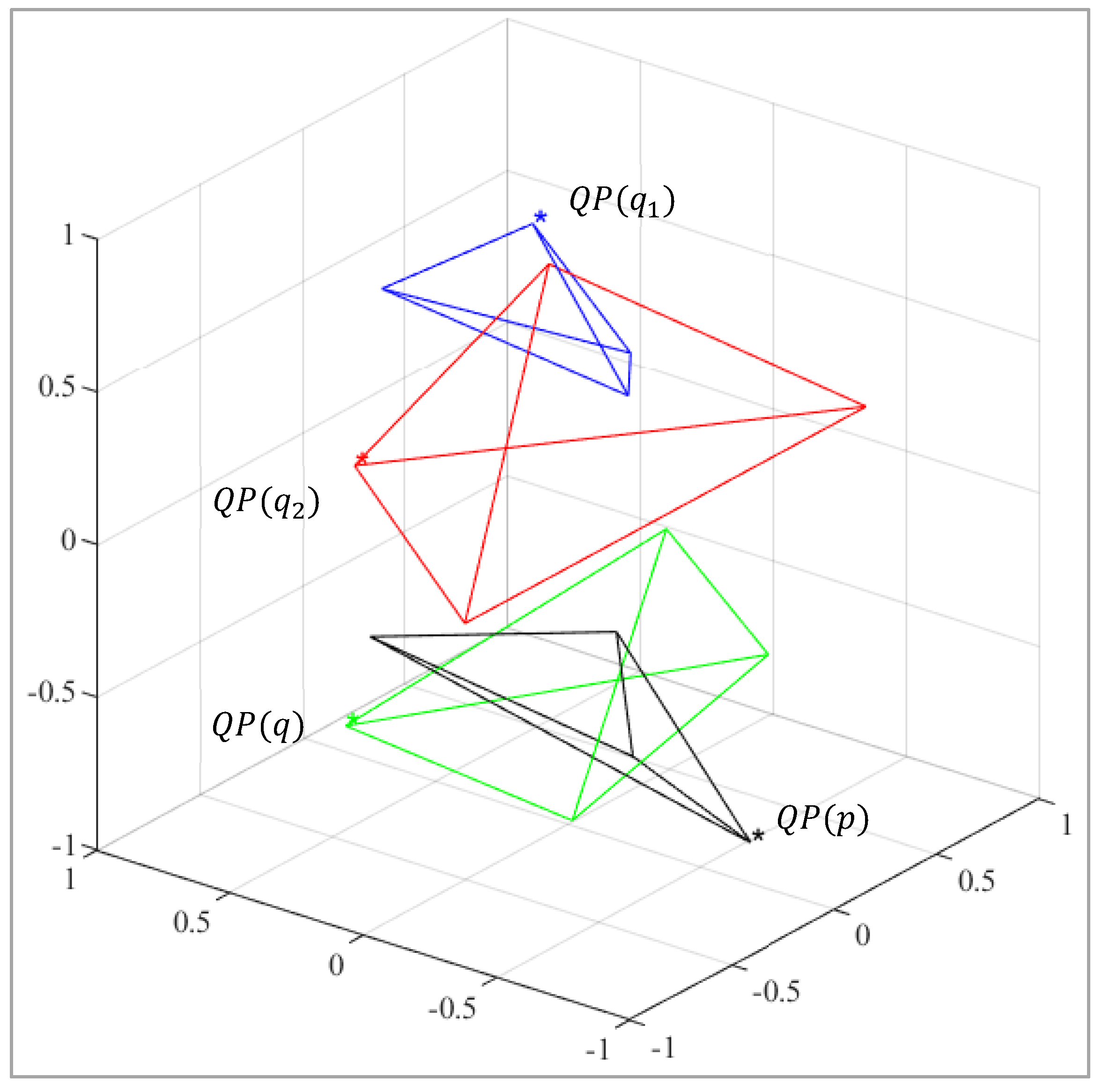


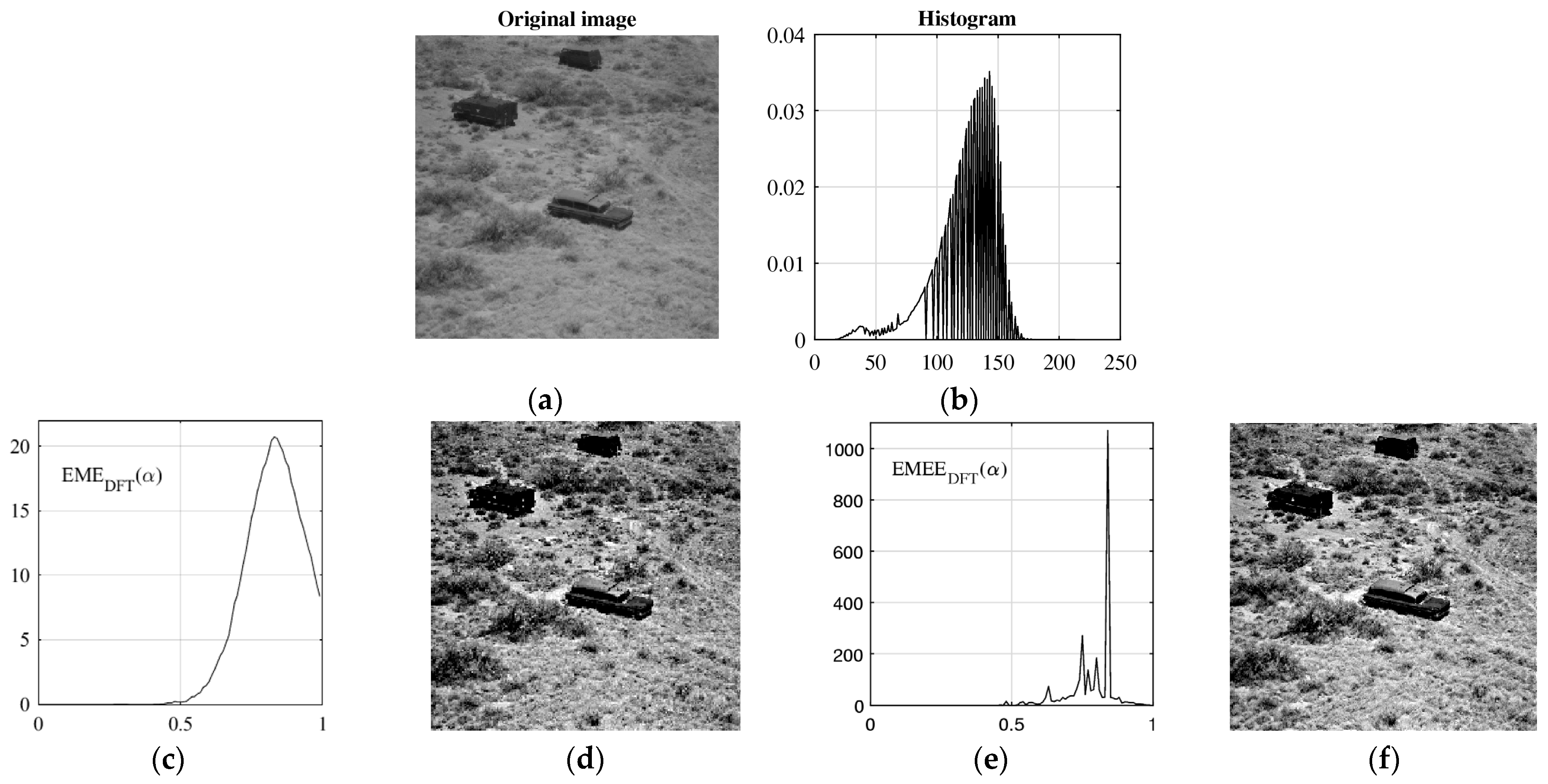





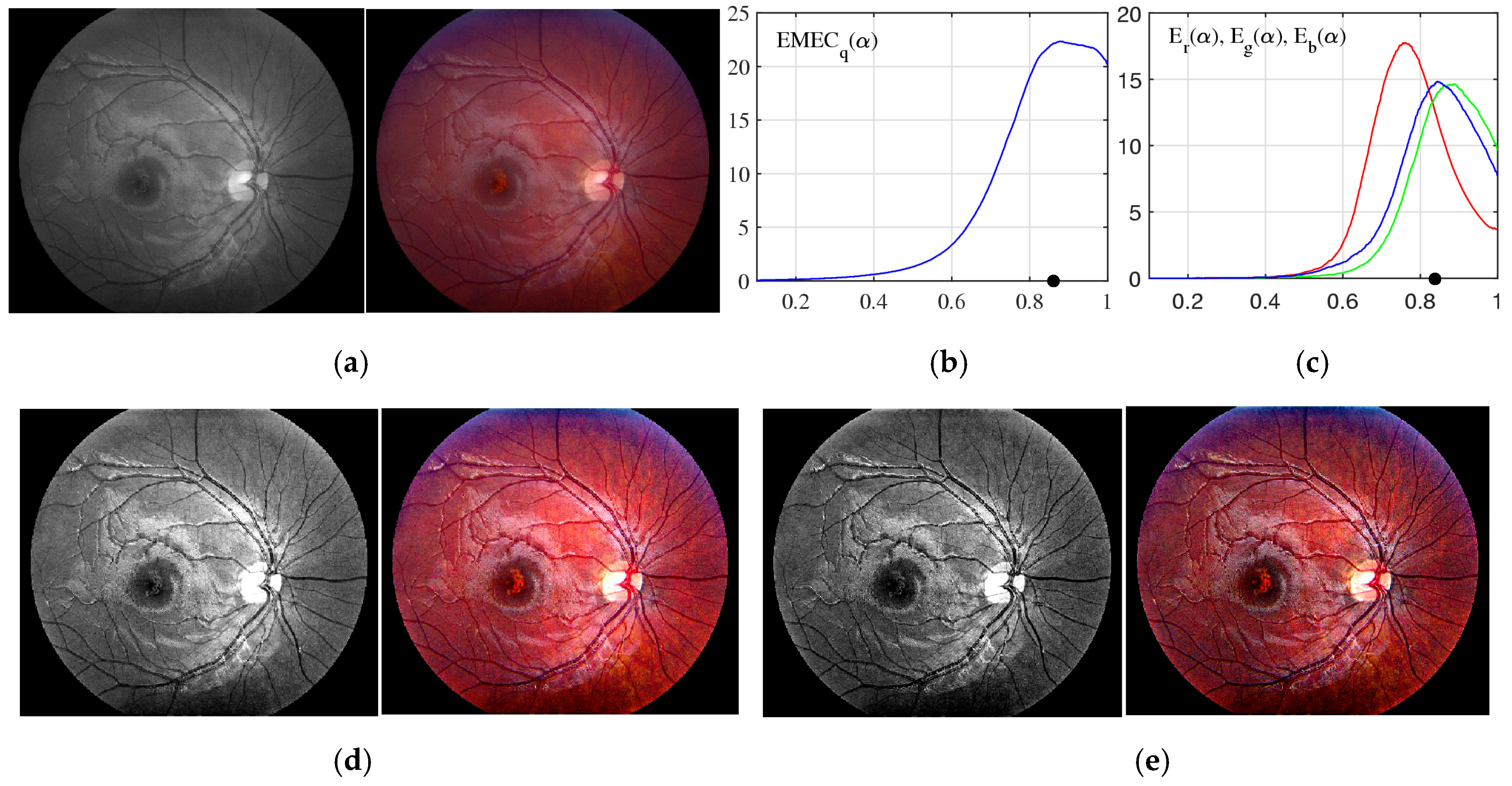
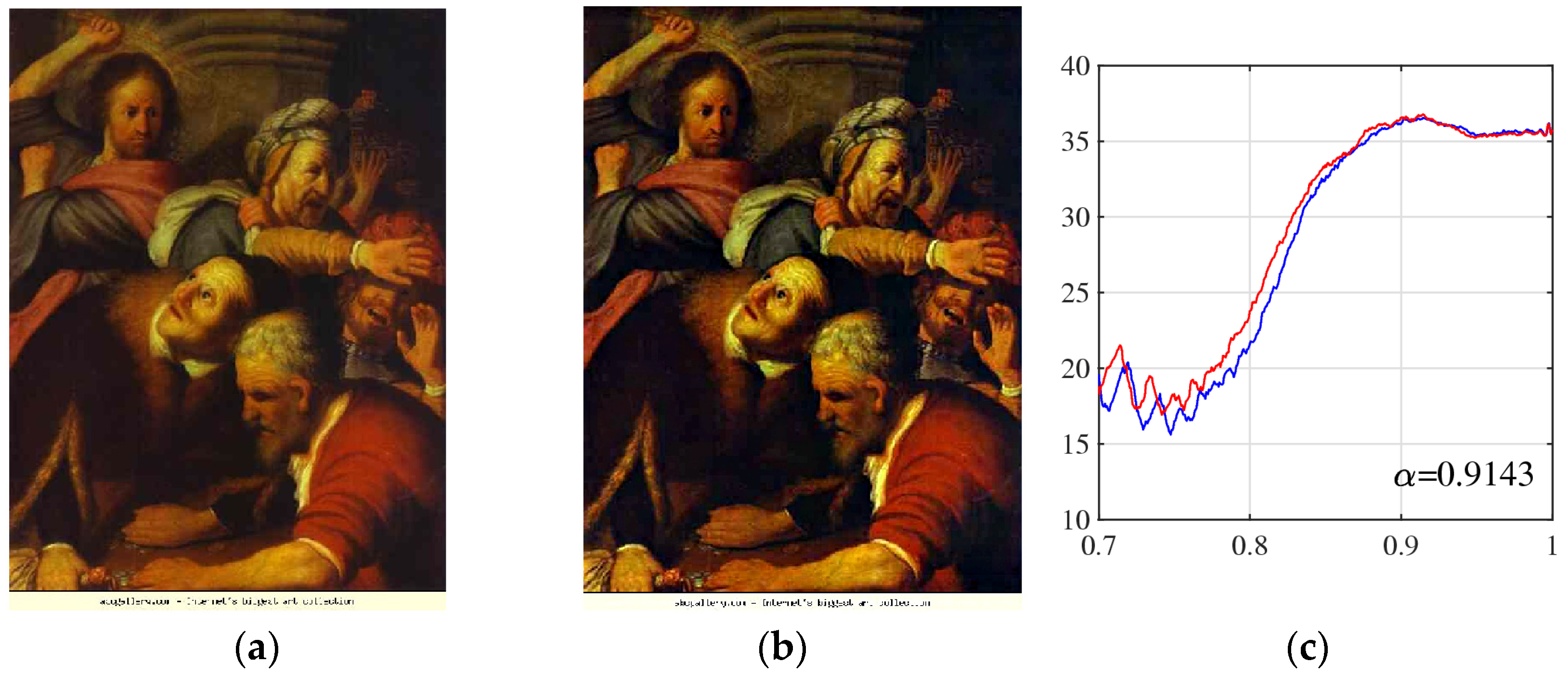
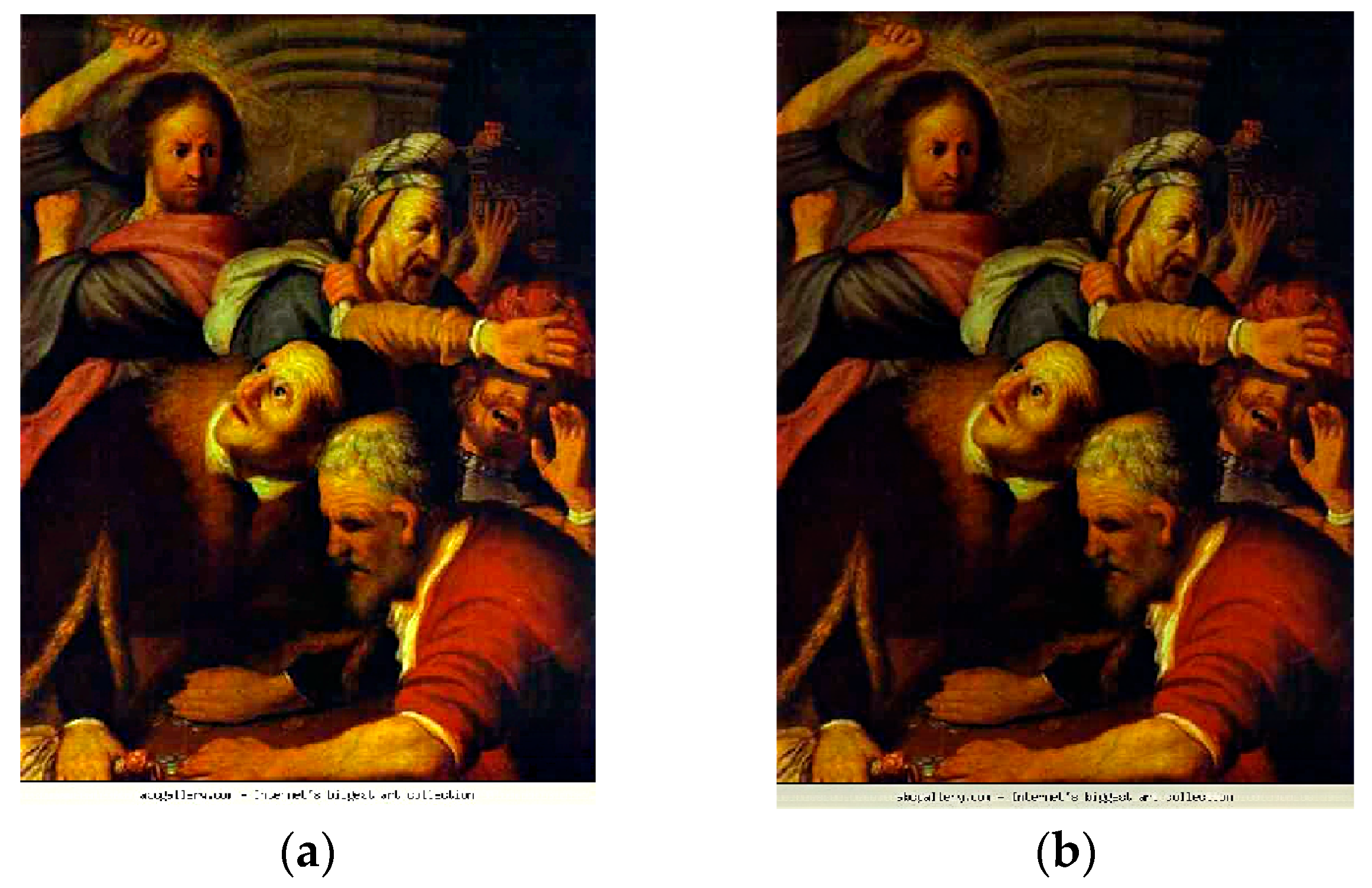




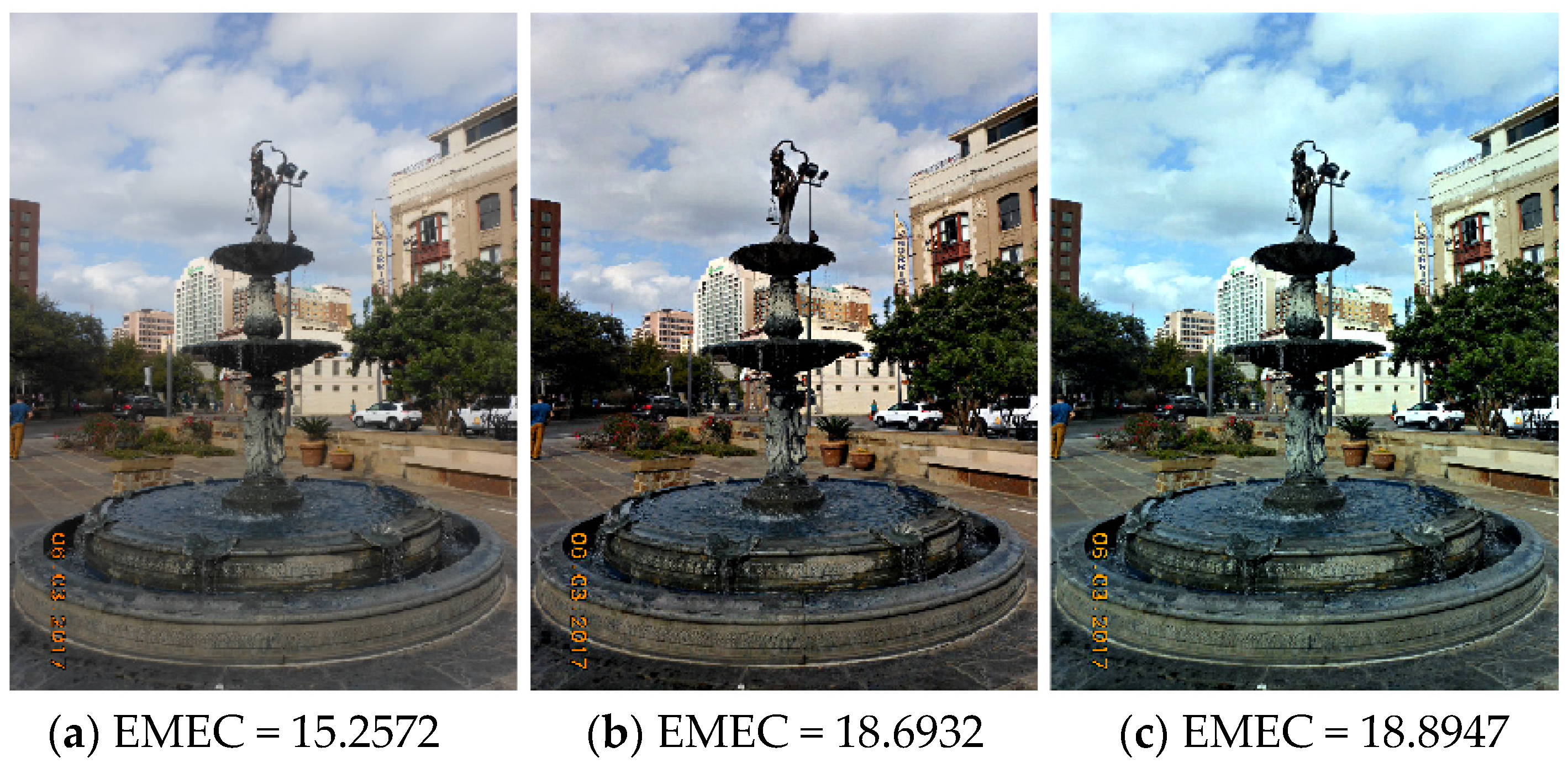



| The (2,2)-Model | The Traditional (1,3)-Model | |||||||
|---|---|---|---|---|---|---|---|---|
| Representation | ||||||||
| Multiplication rules | e1 = 1 | e2 | e3 | e4 | 1 | i | j | k |
| e2 | −1 | e4 | −e3 | i | −1 | k | −j | |
| e3 | e4 | −1 | −e2 | j | −k | −1 | i | |
| e4 | −e3 | −e2 | 1 | k | j | −i | −1 | |
| Multiplication matrix | ||||||||
| Orthogonality | Not | Yes | ||||||
| Commutativity | ||||||||
| Zero “divisors” | =0. | |||||||
| Conjugate | ||||||||
| Quaternion inverse | ||||||||
| Division | ||||||||
| The (2,2)-Model | The (1,3)-Model | |
|---|---|---|
| Aperiodic convolution | ||
| Exponential functions | Only two pairs | Infinite number |
| The pair of the QDFT | Only two | Infinite number |
| Convolution property |
| Model | Transforms | Number of 1D DFTs | Number of Additional Multiplications | Number of Additional Additions |
|---|---|---|---|---|
| The (1,3)-model: | ||||
| General case of | 1D QDFT | 4 (real) | ||
| 2D QDFT | ||||
| Case | 1D QDFT | 4 (real) | - | |
| 2D QDFT | - | |||
| The (2,2)-model: | ||||
| 1D -QDFT | 1D QDFT | 2 (complex) | - | - |
| 2D -QDFT | 2D QDFT | - | - |
Disclaimer/Publisher’s Note: The statements, opinions and data contained in all publications are solely those of the individual author(s) and contributor(s) and not of MDPI and/or the editor(s). MDPI and/or the editor(s) disclaim responsibility for any injury to people or property resulting from any ideas, methods, instructions or products referred to in the content. |
© 2025 by the authors. Licensee MDPI, Basel, Switzerland. This article is an open access article distributed under the terms and conditions of the Creative Commons Attribution (CC BY) license (https://creativecommons.org/licenses/by/4.0/).
Share and Cite
Grigoryan, A.M.; Gomez, A.A. Commutative Quaternion Algebra with Quaternion Fourier Transform-Based Alpha-Rooting Color Image Enhancement. Computers 2025, 14, 37. https://doi.org/10.3390/computers14020037
Grigoryan AM, Gomez AA. Commutative Quaternion Algebra with Quaternion Fourier Transform-Based Alpha-Rooting Color Image Enhancement. Computers. 2025; 14(2):37. https://doi.org/10.3390/computers14020037
Chicago/Turabian StyleGrigoryan, Artyom M., and Alexis A. Gomez. 2025. "Commutative Quaternion Algebra with Quaternion Fourier Transform-Based Alpha-Rooting Color Image Enhancement" Computers 14, no. 2: 37. https://doi.org/10.3390/computers14020037
APA StyleGrigoryan, A. M., & Gomez, A. A. (2025). Commutative Quaternion Algebra with Quaternion Fourier Transform-Based Alpha-Rooting Color Image Enhancement. Computers, 14(2), 37. https://doi.org/10.3390/computers14020037








